India’s new textile policy will focus on a three-pronged approach to boost the growth of the Indian handicraft sector, which is facing tough competition from international players.
The approach involves incentivising expansion of the production base for quality manufacturing of handicraft products used for interior decoration and lifestyle purposes.
The policy is focusing on promoting premium handicraft products for the niche market along with preservation and protection of heritage and endangered crafts.
The new policy aims to achieve 300 billion dollars of textile exports by 2024-25 and envisages the creation of an additional 35 million jobs. Various initiatives have been launched to strengthen textile production and encourage the industry to cater to domestic and international markets efficiently.
The textile industry is a diverse sector, which includes everything from small handloom factories to large garment plants. The sector operates in both organised and unorganised forms and is known for its close association with agriculture.
The government is encouraging investment in the textile sector through 100 per cent foreign direct investment via the automatic route.
In 2014-15, the industry recorded a growth rate of 5.4 per cent. As far as machinery is concerned, 24 per cent of the world’s spindles and eight per cent of the world’s rotors are present in the country.
Policy boosts handloom sector
- 1
- 2
- 3
- 4
- 5
- 6
- 7
- 8
- 9
- 10
Cotton’s fragile comeback, how the US-China truce is redrawing global fiber map
When Presidents Donald Trump and Xi Jinping announced a fragile peace in Busan last week, most of the attention in... Read more
Viscose freed, industry revived as India’s raw material reforms trigger a new MM…
In a policy reversal that has given some relief across India’s textile ecosystem, the Ministry of Textiles has officially rescinded... Read more
Q3 Lyst Index reveals a turning point, Saint Laurent rises, Loewe slumps
In a fashion industry often driven by noise viral micro-trends, rapid-fire drops, and overstated marketing the third quarter of 2025... Read more
India Fashions a Greener Future: Global Fibre Summit spotlights $100 bn export g…
The world's largest fibre innovation congress, the Dornbirn Global Fibre Conference (GFC) Asia, made a landmark debut in Mumbai this... Read more
Techtextil India 2025: Mumbai kicks off 10th edition, focussing on sustainable a…
The premier trade fair for technical textiles, non-wovens, and composites, Techtextil India 2025, commenced today, November 19, 2025, at the... Read more
Fashion’s Next Playbook: Leaders at WWD summit push for radical transformation
On October 29 and 30, the marble halls of Cipriani South Street became the nerve center of a global fashion... Read more
Tariff turbulence spurs transformation in India’s textile value chain
When the US announced a sweeping 50 per cent tariff on Indian textile and apparel imports, the shockwaves reverberated across... Read more
A Punishing Paradox: Is Made in America unravelling the US textile industry?
The Make America Great Again (MAGA) is initiative aimed at breathing new life into US manufacturing, but its impact on... Read more
India's Textile Sector Sews Up Global Trade Alliances in Singapore: Focus on FTA…
The future of India’s textile and textile machinery sector is poised for exponential growth, driven by strategic international collaborations, notably... Read more
QCO rollback and export boost, the two-step formula powering India’s textile com…
November 12, 2025, could go down as a watershed date in India’s textile history. In a single day, the government... Read more












